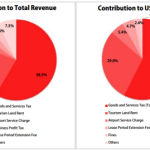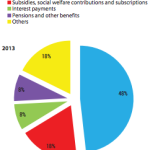The Maldivian economy grew at 8.5 percent in 2014, the central bank has said. Growth was driven by a solid increase in tourist arrivals and the strong recovery of the construction sector.
The government’s fiscal performance in 2014, however, was weaker than anticipated due to shortfalls in revenue and overspending on recurrent expenses, the Maldives Monetary Authority said in its Annual Economic Review.
The International Monetary Fund (IMF) in March provided a much lower figure of five percent for economic growth, and highlighted the need for improved data collection on macroeconomic statistics.
According to the MMA, the government’s total debt reached 65 percent of GDP in 2014, while the fiscal deficit stood at MVR1.6billion or 3.4 percent of GDP, higher than the estimated MVR1.3billion or 2.8 percent.
The tax authority has meanwhile collected MVR951.3million (US$61.9million) in tax revenue in March. The figure is 2.7 percent higher than forecasted as several tourism companies had paid late land rents and fines after the Maldives Inland Revenue Authority (MIRA) froze the accounts of some 20 businesses in April.
MIRA has received MVR 5.61 billion (US$ 360 million) in revenue this year, an increase of 27.3 percent compared to 2014. The tax authority, however, did not state if revenue collection meets targets.
Robust growth
Some 1.2million tourists brought in an estimated US$2.6 billion to the Maldives in 2014. Arrivals grew by 7 percent and was largely driven by arrivals from China. European arrivals recorded a marginal growth due to a decline in Russian tourists.
The growth in bed nights stood at 4 percent – slight lower in magnitude than the growth in arrivals – reflecting the decline in average stay from 6.3 days in 2013 to 6.1 days in 2014. The downward trend in average stay, which has become more marked since 2009, is due to a shift in the composition of inbound tourist markets towards countries such as China, the MMA said
Meanwhile, total tourist revenue remained buoyant and grew by 13% (20% growth in 2013) to reach an estimated US$2.6 billion during 2014. The significant difference between the growth in revenue and bednights may reflect the increase in tourist expenditure on high-end services in the industry, the MMA said.
Airline movements by international carriers, such as Mega Maldives, Cathay Pacific and budget airlines such as Tiger Airways, also increased during the year, and facilitated the growth in tourist arrivals.
Three new resorts were opened, increasing total registered number of resorts in the Maldives to 112. Registered guesthouses reached a total of 216. Some 80 new guesthouses were registered at tourism ministry, but only a total of 95 in operation.
The construction sector bounced back from two consecutive years of negative growth. The revival was mainly due to the ease in obtaining construction materials after India waived restrictions on the export of stone aggregate to in March 2014. This allowed the resumption of large-scale public sector infrastructure projects and major housing projects, the MMA said.
The fisheries sector declined by 6 percent, following a strong growth of 8 percent in 2013, due to a decline in fish catch, and also because of the significant dip in international tuna prices.
The fishing industry in the Maldives represents about one percent of GDP in 2014. It accounted for 10% of total employment in 2010. Export revenue from fish and fish products accounts for 47 percent of merchandise exports.
Poor fiscal performance
The government collected some MVR14.5billion in revenue in 2014. But total revenue fell short of the target as some of the new revenue measures planned in the budget did not materialize.
The implementation of of a T-GST hike – from 8 percent to 12 percent – was delayed from July 2014 to November 2014; tourism tax, initially anticipated to be collected throughout the year was only collected from February to November.
There was a “considerable shortfall” from the lease period extension fee collected during the year. The lump-sum resort acquisition fee from the 12 new islands planned to be leased out for resort development did not materialize either.
As a result, total revenue was MVR351.0 million less than budgeted and amounted.
The total expenditure of MVR16.5 billion was slightly lower than budgeted, but only because the government stopped spending on development projects and redirected funds to financing recurrent expenditure.
In the banking sector, the main area of concern continued to be credit risk, as indicated by the high level of poor-quality loans. Non-performing loans “remain a concern with a ratio of 16 percent,” the MMA said.
Gross international reserves increased to US$614.7 million at the end of the year. Out of this, usable reserves accounted for US$143.9 million. The “marked expansion” owed to the improvement in foreign currency receipts of the government, the MMA said.






